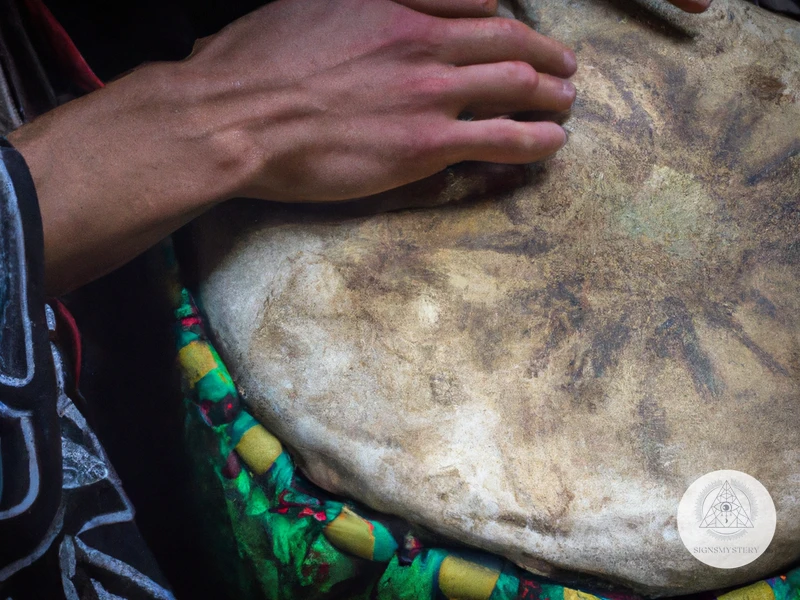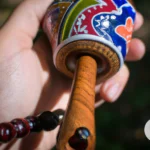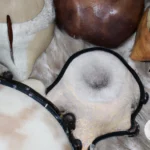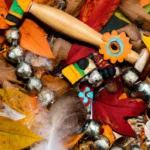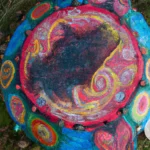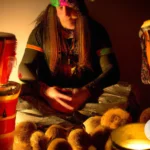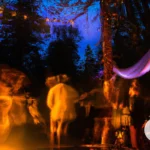Have you ever felt the transcendental power of shamanic music in your bones? The rhythmic beats and melodious sounds of shamanic instruments have the ability to alter our consciousness and connect us to the spiritual realm. But have you ever wondered about the significance of each instrument in shamanic music? In this article, we will delve into the origin, symbolism, benefits, and techniques for playing different shamanic instruments such as drums, rattles, flutes, singing bowls, and chants. By exploring the unique qualities of each instrument, you can learn how to incorporate them into your own shamanic practice and deepen your connection to the spiritual world.
Drums
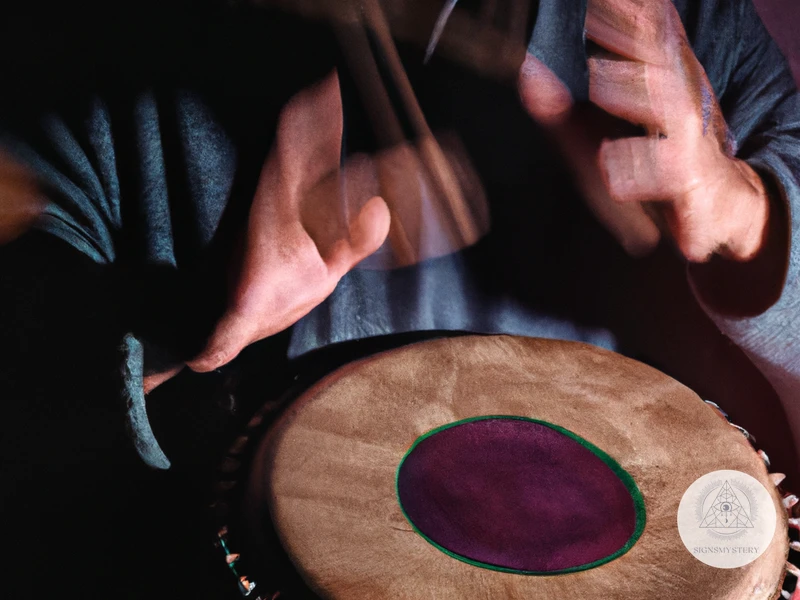
Drums are perhaps the most iconic instrument used in shamanic music. The origins of shamanic drums can be traced back to the earliest human societies, making them a particularly potent symbol in shamanic practices. The symbolism surrounding drums is often tied to the concept of the heartbeat, as the steady, rhythmic beat of a drum can mimic the sound of a heartbeat. This connection to the heartbeat makes drums a powerful tool for inducing trance-like states and altered states of consciousness. In shamanic practice, drums are often used to set the pace and rhythm for other instruments and vocalizations. Traditional drums are made from animal hides and are often adorned with symbols and designs that hold spiritual significance. There are several types of shamanic drums, including frame drums and barrel drums, each with its own unique sound and function. Playing shamanic drums can have profound physical and psychological benefits, including reduced stress and anxiety and improved focus and concentration. It is believed that the act of drumming allows one to connect with the rhythms of nature and the universe, making it a crucial component of shamanic music.
Origin and Symbolism
Origin and Symbolism of Shamanic Instruments
Every shamanic instrument has a unique origin and symbolism, which contributes to its significance in shamanic music. These instruments were created by ancient cultures to connect with the spirit world and convey meaningful messages through sound and movement.
The drums used in shamanic music, for instance, can be traced back to ancient civilizations, such as the indigenous tribes of Siberia and Mongolia. These cultures believed that the drum represented the heartbeat of Mother Earth and communicated with the spirits of nature through its rhythmic beats. The drums were also said to symbolize the human heart and help the shaman reach a meditative state during a ceremony.
Similarly, rattles have been used in shamanic music for thousands of years and were originally created from natural materials such as gourds, turtle shells, and dried seed pods. Many indigenous cultures in the Americas believed that the sound of the rattle was the voice of the Great Spirit and used it to communicate with the divine.
Flutes have been used in shamanic music for centuries and have been found in various cultures around the world. In ancient times, flutes were made from bones, shells, and feathers. They were believed to be capable of connecting the physical world with the spiritual realm and were often used in healing ceremonies and trance-inducing rituals.
Singing bowls, which were first used in Tibet, are believed to be a symbol of wholeness and are often used in meditation and relaxation practices. Their origin can be traced back to the Buddhist tradition, where they were used during chanting and prayer to help practitioners focus their attention and enter into a state of peace.
Finally, vocalizations and chants have been a significant aspect of shamanic music and are believed to have been used since prehistoric times. Chants and vocalizations are considered sacred by many indigenous cultures and are believed to have the power to heal, protect, and connect with the spiritual realm. They are often used in conjunction with other shamanic instruments to induce a trance-like state, which helps the shaman access the spirit world.
Understanding the origin and symbolic significance of shamanic instruments gives insight into the deeper meaning behind shamanic music. By exploring the cultural and spiritual background of these instruments, we gain a greater appreciation for their role in shamanic ceremonies. If you’re curious to learn more about the role of traditional chants in shamanic ceremonies, check out this article on our website.
Benefits in Shamanic Practice
In shamanic practice, music plays an essential role. Each instrument used in shamanic music brings its own set of benefits to the practice. Drums, for instance, are known to be the most ancient and most widely used in shamanic practice. The steady rhythm of the drum beat helps to induce a trance-like state, leading to altered states of consciousness. In these states, shamans can access the spiritual and physical realms, gaining insight and guidance for themselves and their communities.
Similarly, rattles have a powerful impact on shamanic practice. The sound of the rattle is believed to help clear negative energy and spirits, allowing for a more profound connection to the divine. Rattles are also used for healing purposes in shamanic ceremonies. By shaking the rattle over the body of a patient, negative energy is believed to be dispersed, promoting healing.
Flutes, on the other hand, are known for their calming and meditative effect. Their gentle tones can help to bring about a sense of peace and tranquility, which can be useful in shamanic journeying or meditation. The sound of the flute can help to open up the heart and connect to one’s emotions, which can be powerful in shamanic healing practices.
Singing bowls also have significant benefits in shamanic practice. The sound vibrations produced by the singing bowl is believed to help with chakra alignment, promoting spiritual and physical healing. Like the rattle, singing bowls are believed to be powerful tools for clearing negativity and creating a sacred space in shamanic ceremonies.
Finally, chanting and vocalizations have been used in shamanic practice for thousands of years. The repetitive nature of the chant can help to induce a trance-like state, and the vibration of the voice can help to clear negative energy and promote healing. These chants are often used in shamanic ceremonies, and many traditional shamanic chants have been passed down from generation to generation.
Each instrument used in shamanic practice brings unique benefits to the ceremonies. Drums, rattles, flutes, singing bowls, and chanting all play an essential role in shamanic music and are used for journeying, meditation, healing, and connection to the divine. If you’re interested in learning more about shamanic music, you may want to check out some of the related articles like Exploring the Significance of Shamanic Songs, Healing with Shamanic Drumming and Chanting, Learn to Perform Traditional Shamanic Chants, and Cultural Significance of Shamanic Music.
Techniques for Playing
When it comes to playing shamanic instruments, there are various techniques that can be employed to create specific sounds and vibrations. Here are some techniques for playing some of the most popular shamanic instruments:
Drums
One of the most common techniques for playing a shamanic drum is to use a steady heartbeat rhythm. This involves striking the drumhead in a consistent pattern, mimicking the steady beat of a heartbeat. Another technique is to play the drum in a circular motion, creating a continuous flow of sound. Experimenting with different levels of force and speed can also create a variety of sounds and effects.
Rattles
When playing a shamanic rattle, shaking it rapidly can create a high-pitched, vibrating sound. Alternatively, shaking it slowly can create a deeper, more resonant sound. Rattles can also be played by tapping or striking them against different surfaces, such as the palm of the hand or a hard surface.
Flutes
The main technique for playing a shamanic flute involves controlling the air flow through the instrument. Players can create different notes and sounds by adjusting the amount of air they blow into the flute and changing the position of their fingers on the instrument’s openings. Breathing techniques, such as circular breathing, can also be used to create continuous notes without pausing for breath.
Singing Bowls
To play a shamanic singing bowl, the player must strike the bowl with a mallet to create a ringing sound. The player can then use the mallet to create a continuous ringing sound by rubbing it around the edge of the bowl. Varying the pressure and speed of the mallet can create different tones and vibrations.
Chants and Vocalizations
Vocal techniques for shamanic chants and vocalizations include using different pitches, tones, and rhythms to create specific sounds and effects. Chants can be sung in unison or in harmony with other voices, and can also incorporate elements of breathing and throat techniques to create unique sounds. Vocalizations can also include guttural sounds and animal noises to enhance the shamanic experience.
These techniques can be built upon and combined to create an even wider range of sounds and vibrations from these shamanic instruments. By experimenting with the techniques and finding what works best for them, shamanic practitioners can create deeply resonant and spiritual experiences in their practice.
Types of Shamanic Drums
Shamanic drums come in various sizes and shapes. Understanding the different types is essential for beginners who want to explore shamanic music.
Frame Drums
Frame drums are the most common type of shamanic drum used in traditional and modern shamanic practices. These drums have a circular frame that supports a stretched drumhead, which is usually made from animal skin. The frame is commonly made from wood, metal or bamboo. The sound produced by this type of drum is sharp and deep, making it ideal for journeying, dance, and meditation.
Ceremonial Drums
Ceremonial drums, also known as spirit drums, are larger than frame drums and are used mostly in sacred ceremonies and rituals. These drums produce a deeper and more powerful bass sound that can create a strong rhythm for dancing and meditation. Typically, these drums are made from materials such as elk or buffalo hides and are hand-painted with powerful symbols and designs.
Bodhrans
Bodhrans are a type of frame drum that originated in Ireland. This type of drum has a shallow or flat frame, making it easier to hold and play. The drumhead can either be made from animal skin or synthetic materials such as plastic or Fiberskyn. Bodhrans are commonly used in Celtic shamanic practices and produce a bright and lively sound.
Cougar Drums
Cougar drums, also known as powwow drums, are large frame drums that are used in Native American shamanic practices. They are made from a hollowed-out log with a stretched animal skin drumhead. The drumhead is usually painted with beautiful designs and symbols. These drums produce a deep and resonant sound that is perfect for ceremonial and ritualistic purposes.
Klong Yao Drums
Klong Yao drums are used in Thai shamanic rituals and resemble a cross between a bass drum and a conga drum. They have a long body made of wood or bamboo and a cowhide head. Klong Yao drums produce a deep and mellow sound that perfectly complements shamanic chanting and singing.
Each type of shamanic drum provides a unique sound and feel, making them suitable for different purposes and traditions. Aspiring shamanic practitioners should consider experimenting with different types of drums to find the one that resonates with their personal style and practice.
Rattles
Rattles have been a part of shamanic music for centuries, and are often used alongside drums to build up a powerful rhythm. They have a deep symbolic significance in many cultures, representing the cosmic forces that govern the universe. The shaking of a rattle is said to help connect to these forces and create a sense of unity with all living things. In shamanic practice, rattles are used for a variety of purposes, including healing, vision quests, and calling on spirits for guidance. There are many types of rattles used in shamanic music, each with its own unique sound and characteristics. Some of the most common types include gourd rattles, hoop rattles, and shaker rattles. Techniques for playing rattles include shaking them in different directions, varying the speed and intensity of the shaking, and using them to create complex rhythms. Rattles are an important instrument in shamanic music, helping to create a powerful and transformative experience for those who practice it.
Origin and Symbolism
Drums: The drum is one of the most ancient and powerful instruments used in shamanic music. Its deep, rhythmic beat, often accompanied by chanting, is believed to be a way to communicate with the spirit world and helps to facilitate trance states. In many indigenous cultures, the drum is considered sacred and is often used as a tool for healing as well as for communicating with ancestors and spirits. The symbolism of the drum varies from culture to culture, but generally, it represents the heartbeat of the earth and is a way to connect with the natural world.
Rattles: Rattles are another important instrument in shamanic music, and like drums, are often used to facilitate trance states and communicate with the spirit world. They are usually made from natural materials such as gourds, shells, or bones, and are filled with seeds, stones, or other objects that create a rattling sound when shaken. In many cultures, the rattling sound of the instrument is believed to help drive away negative energies and spirits, making it an important tool for purification rites.
Flutes: The origins of the shamanic flute can be traced back to many indigenous cultures, including those of the Native Americans and the Andean people of South America. The flute was often used to evoke feelings of peace and harmony, and its gentle melodies were thought to attract positive energies and spirits. In some cultures, the sound of the flute was believed to be the voice of the wind or the spirit of nature, and its music was used to celebrate the cycles of life and the changing seasons.
Singing Bowls: Singing bowls have been used in shamanic music for centuries and are believed to have originated in the Himalayas. The bowls are made of metal and produce a sustained tone when struck or played with a mallet. They are often used in meditation, sound healing, and shamanic rituals to help people relax, find inner peace, and connect with the spirit world. In many cultures, the sound of the singing bowl is believed to represent the eternal sound of the universe and the oneness of everything.
Chants and Vocalizations: Chants and vocalizations are an essential part of shamanic music, and have been used by indigenous cultures for centuries to communicate with the spirit world. The sounds created by the human voice are thought to have a powerful effect on the body and mind, and can be used to induce trance states, evoke emotions, and connect with the natural world. In many cultures, chants and vocalizations are used to honor the ancestors and spirits and create a sense of unity and community amongst the participants in a shamanic ritual.
Benefits in Shamanic Practice
The use of instruments in shamanic practice is believed to have numerous benefits for the practitioner. These benefits include inducing altered states of consciousness, facilitating communication with spirits and ancestors, and promoting healing on physical, emotional, and spiritual levels.
Drums, for example, offer a powerful and rhythmic sound that can assist in entering a trance state. The steady beat can help focus the mind and body, while the vibrations of the drum can act as a conduit for connecting with spiritual energies. Rattles, on the other hand, produce a more chaotic and unpredictable sound that is believed to help break through mental barriers and dissolve negative energy.
The use of shamanic flutes and singing bowls can elicit a sense of calm and peacefulness, allowing the practitioner to access deeper levels of consciousness and spiritual insight. The breathwork involved in playing the flute can also enhance the practitioner’s connection to the natural world and the rhythms of life.
In addition, vocalizations such as chants and mantras can be a powerful tool for invoking spiritual energies and setting intentions. The use of the voice can help to release emotions and energies that are holding the individual back, and create a vibration that harmonizes with the energy of the universe. By chanting or singing in a group, practitioners can also create a collective energy that can amplify the effects of shamanic practice.
The benefits of using instruments in shamanic practice are diverse and profound. From inducing altered states of consciousness to promoting healing on all levels, the incorporation of shamanic instruments into spiritual practice can provide a powerful tool for personal growth and transformation.
Techniques for Playing
Techniques for playing shamanic instruments vary according to the type of instrument, as each one requires a specific approach. In this section, we will explore the key techniques for playing each of the four main types of shamanic instruments – drums, rattles, flutes, singing bowls, and vocalizations.
Drums
Playing the shamanic drum involves more than just hitting it continuously. The drummer must try to connect with the spirit of the drum and bring it to life through their playing. Here are some key techniques for playing the shamanic drum:
| Technique | Description |
| Beater Strike | The drummer should ideally hit the drumhead in the center with a beater. This produces a deep resonant sound that connects to the earth and otherworldly spirits. |
| Drum Tones | Depending on where the beater strikes the drumhead, different tones are produced. The rimshot produces a higher-pitched tone, while the center hit produces a deeper tone. |
| Drumming Pattern | The drummer should maintain a steady rhythm while keeping an open mind to any variations or changes in tempo. It’s important to listen to the energy of the circle and adjust the drumming accordingly. |
Rattles
Rattles are essential for creating a trance-like state in shamanic ceremonies. They can be shaken or struck against the body in different ways to create a range of sounds and vibrations, each with their own unique effect. Here are some key techniques for playing rattles:
| Technique | Description |
| Shaking | Hold the rattle lightly and shake it either up and down or side to side, keeping in mind the rhythm of the ceremony or the song being sung. |
| Tapping | Tapping the rattle against the body, the ground or another instrument creates a sharp, percussive sound. |
| Circular Motion | Moving the rattle in a circular motion produces a soothing, continuous sound that helps create an immersive experience for the participants in the ceremony. |
Flutes
Shamanic flutes have been used for thousands of years to create calming and relaxing melodies that produce a meditative state. Playing a shamanic flute involves not just blowing air into it but also controlling the airflow and the sound that is produced. Here are some key techniques for playing the shamanic flute:
| Technique | Description |
| Breath Control | Controlling the airflow into the flute can produce different pitches and rhythms. It’s important to remember to use the diaphragm muscle as opposed to just the mouth or lungs. |
| Finger Placement | Finger placement on the holes of the flute can produce different notes and melodies. Understanding how to place fingers correctly allows for more intricate and complex tunes. |
| Embouchure | The position of the mouth on the flute’s mouthpiece can also affect the pitch and tone of the music. Experimenting with different positions can result in different sounds. |
Singing Bowls
Singing bowls produce a unique sound that touches the subconscious mind, helping to promote relaxation and healing. Playing a singing bowl requires skill and knowledge of how to make the bowl ‘sing’ by following the appropriate methods. Here are some key techniques for playing a singing bowl:
| Technique | Description |
| Striking | Tap the bowl gently with a mallet to produce a rich and deep sound, without producing any jarring or sudden noise. |
| Circular Motion | Place the bowl on the palm of the hand and create a circular motion around the rim with the other hand to produce a resonant sound. Varying the speed of the rotation can change the pitch and intensity of the sound. |
| Manipulating vibrations | Gently press the mallet around the rim of the bowl to create a harmonic pattern of vibrations. Understanding how to manipulate these vibrations can create mesmerizing soundscapes. |
Chants and Vocalizations
The human voice has been used in shamanic practices for centuries to connect with the divine and to enter otherworldly states. The voice can be used to create and harmonize with different sounds to produce unique effects. Here are some key techniques for vocalizations and chants in shamanic ceremonies:
- Breath Control: Controlling the pace and intensity of the breath can create different rhythms during chants and vocalizations.
- Pitch Control: Changing the pitch and tone of the voice can produce different harmonies and layering during chants, creating rich and complex soundscapes.
- Intention: The intention behind the voice is critical in shamanic practices. The shaman must focus their intention on the purpose of the ceremony and channel it through their voice to create the desired effect.
By understanding the techniques and methods for playing shamanic instruments, we can channel our energy and intention towards creating transformative and immersive experiences that connect us to the divine and ourselves.
Types of Rattles
When we talk about the types of rattles used in shamanic music, we come across various options that are unique and diverse in nature. One of the most popular types of rattles is the gourd rattle, it is a common type of rattle made with dried gourds. Gourd rattles have been used in the Americas for centuries and are favored not only for their sound but also for their symbolic importance. They are typically decorated with intricate designs and symbols, each with a unique meaning.
Another type of rattle commonly used in shamanic music is the seed rattle. These rattles are made with small seeds enclosed in a container, often a gourd or a small pouch. The sound produced by the seed rattle is more gentle and less pronounced than the gourd rattle, and they are often used in more meditative shamanic practices.
The rawhide rattle is yet another type of rattle that is popular in shamanic music. Rawhide rattles are made with animal hide, often deer or elk skin, stretched over a wooden handle. These rattles are typically larger than gourd or seed rattles and produce a deep, resonant sound. They are often used in shamanic practices that involve trance-inducing drumming.
The shamanic music tradition also includes the use of metal rattles. These rattles produce a distinct jingling sound and are often used for their powerful and penetrating sound. Metal rattles are often made from materials like bronze, copper, and aluminum, and are sometimes decorated with intricate designs or symbols.
The types of rattles used in shamanic music are diverse and each have their own unique characteristics and symbolic importance. The choice of rattle often depends on the specific shamanic practice being performed and the intentions of the shaman or participant. By exploring the different types of rattles used in shamanic music, we can gain a deeper understanding of the rich and complex world of shamanic practice.
Flutes
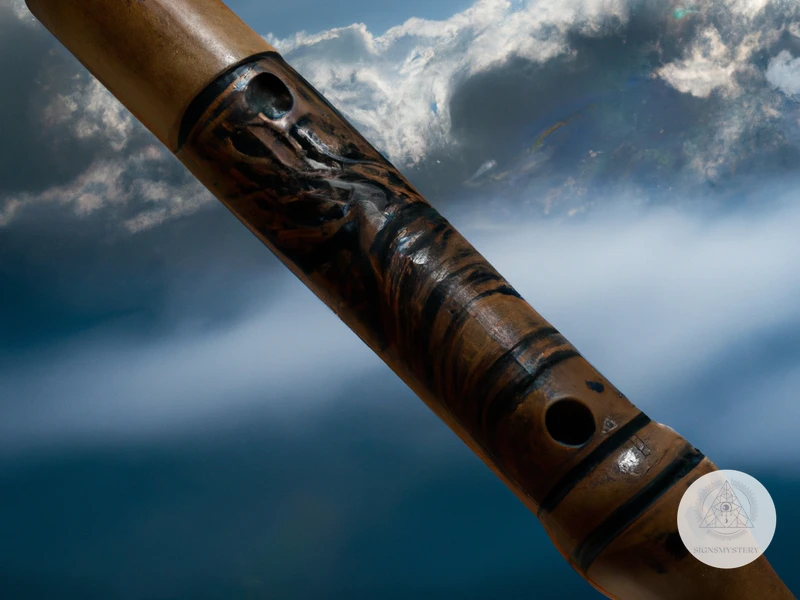
Historically, the use of flutes in shamanic practices can be traced back to many indigenous cultures around the world. Flutes are believed to have healing powers, as playing them can create an altered state of consciousness that is conducive to healing. The flutes’ soft and gentle melodies are said to calm the mind and create a sense of relaxation, which is essential in shamanic practices. Each type of flute, such as Native American flutes or Chinese flutes, is believed to have its unique healing properties and significance in shamanic rituals. Some of the most commonly used types of shamanic flutes include the Anasazi flute, the Hopi flute, and the Mayan triple flute. To play the flute in shamanic practice, one must master certain techniques such as breath control and articulation, and it is essential to choose the right type of flute based on the desired purpose and ritual. The flute is an integral instrument in shamanic music, and its significance and healing properties have been recognized in cultures worldwide.
Origin and Symbolism
Each instrument used in shamanic music has a unique origin and symbolism associated with it. The significance of these instruments varies depending on the culture and regional differences. Let’s explore the origin and symbolism of some of the commonly used instruments in shamanic music.
| Instrument | Origin | Symbolism |
|---|---|---|
| Drums | Drums have been used for thousands of years by various cultures around the world for spiritual and cultural purposes. In shamanic practices, drums were believed to connect the shaman with the spirit world and the ancestors. | The circular shape of the drum represents the circle of life and is thought to symbolize the cycles of the universe. The rhythm produced by the drum is believed to represent the heartbeat of the mother earth, and the sound is used to communicate with spirits. |
| Rattles | Rattles date back to ancient times and were used in various forms across the world. In shamanic practices, the rattle was believed to be a tool for communicating with the spirit world and used for healing purposes. | The sound of the rattle is said to mimic the sound of raindrops, and as such, it is believed to represent the watery world of the spirits. The small objects inside the rattle are considered to be the spirits themselves and their movement is seen as a way of summoning the spirits. |
| Flutes | Flutes were used in almost every ancient culture and were used for both spiritual and everyday purposes. In shamanic practices, flutes were used to create a trance-like state and were believed to create a bridge between the physical and spiritual worlds. | The sound of the flute is said to mimic the natural sounds of nature, and as such, it is believed to be used for healing purposes. The simple design of the flute is believed to represent simplicity and purity, and the breath required to play it is seen as a symbol of life itself. |
| Singing Bowls | The origins of singing bowls are not entirely known, but they were used in various forms across different cultures. In shamanic practices, singing bowls were used for energy cleansing and as a tool for meditation. | The sound produced by the singing bowl is said to represent the sound of the universe, and the vibrations are believed to have a healing effect on the body and mind. The circular shape of the bowl is seen as a representation of the universe, and the harmony produced by the singing bowl is thought to bring balance and peace. |
| Chants and Vocalizations | Chants and vocalizations have been a part of shamanic practices since ancient times. They are used to create a meditative state and establish a connection with the spirit world. | The lyrics of the chants are usually symbolic and filled with meaningful messages that are intended to bring about healing and understanding. The sound produced by the voice is believed to have a direct impact on the spirit world, and the rhythm and tone are used to create a specific atmosphere and connection to the spirits. |
Understanding the origin and symbolism of each instrument is an essential part of shamanic practices. The unique qualities of each instrument allow for a deep connection to be established with the spirit world and the universe. By using these instruments properly, shamanic practitioners believe that they can tap into ancient wisdom and find new ways to heal and connect with the world around them.
Benefits in Shamanic Practice
Benefits in Shamanic Practice
In shamanic practice, instruments play a crucial role in inducing a trance-like state, connecting to spiritual realms, and aiding in the journey of self-discovery. The powerful vibrations and rhythmic beats produced by instruments help in altering the consciousness of practitioners, leading them towards a state of inner peace, relaxation, and expanded awareness.
Shamanic music has been used for centuries to stimulate the senses and calm the mind. It helps in reducing stress, anxiety, and depression, promoting a sense of well-being and emotional balance. The combination of drums, rattles, flutes, singing bowls, and chants creates a healing environment, which aids in releasing emotional blockages, negative energy, and trauma.
Playing instruments in shamanic practice is not only a means of communication with spirits but also a way of connecting with the natural world. The music produced by instruments resonates with the energy of the earth, thus promoting harmony and balance with nature. The vibrations produced by the instruments also help in balancing the chakras, releasing energy blockages in the body and promoting physical healing.
Playing instruments provides a sense of empowerment to the practitioner, allowing them to take charge of their spiritual journey. The sounds produced by the instruments evoke a primal response, awakening the innate wisdom and intuition within us. Practitioners can use the instruments to direct their energy, set intentions, and connect with their spirit guides, leading them towards a deeper understanding of themselves and the universe.
The benefits of using instruments in shamanic practice are plenty. They promote emotional, physical, and spiritual healing, balance the energies within and around us, and aid in our journey of self-discovery. Instruments have been used for centuries by shamans worldwide and continue to hold a significant place in shamanic culture to this day.
Techniques for Playing
When it comes to playing shamanic instruments, there are various techniques utilized by traditional healers around the world. Each instrument requires a unique approach and technique to produce the desired sound and effect during Shamanic practice.
Drums: To get the most out of Shamanic drums, the player should position the drum on a surface that’ll resonate the sound. Once in position, the drummer can use a combination of wrist flicks, arm motions, and strikes to create varying tempos, beats, and rhythms. The drummer can also use his or her fingers or a drumstick to produce different tones and pitches from the drum.
Rattles: Rattles come in various types, and each requires a unique technique to play successfully. However, the most common technique involves shaking the instrument rhythmically to create a consistent sound. Depending on the type of rattle, the player can use his or her fingers or wrist to create different tones and rhythms.
Flutes: Flutes require a specific set of techniques to play shamanic music. The player should create a seal with his or her lips around the mouthpiece while blowing into the instrument to produce a unique sound. The technique also involves covering and uncovering the instrument’s finger holes to produce varying notes and tones.
Singing Bowls: The most effective way to play singing bowls is by using a stick to strike the bowl’s rim, creating a ringing sound that continues even after stopping. The player can also use the stick to rub the bowl’s rim to produce a humming sound and continue the vibration. The bowl’s shape and size also play a massive role in producing different sounds.
Chants and Vocalizations: Shamanic chants involve a distinctive singing technique that requires the singer to produce different pitches and rhythms to achieve the desired effect. The technique involves using the tongue, breathing, and mouth to produce a unique sound that creates a trance-like environment during a Shamanic ceremony.
Mastering these techniques takes time and practice. By using them in combination with various other tools and meditative practices, Shamanic musicians create a deeply immersive experience for their listeners, ushering them into a trance-like state that enhances spiritual connection and growth.
Types of Shamanic Flutes
Shamanic music makes an extensive use of flutes, which come in different
Subscribe to Our Newsletter
Sign up to receive the latest news and updates.
The Anasazi flute is a type of shamanic flute that is believed to have originated in the American Southwest. It is made out of wood and has a unique construction that makes it distinct from other flutes. The two-chambered construction allows for a deeper, more resonant sound that is associated with shamanic music. The Eastern European shepherd’s flute is another type of shamanic flute that has its roots in the ancient beliefs of Eastern Europe. It is typically made out of wood or bone and has a distinctive, haunting sound that resonates with the shamanic tradition.
The Chinese dizi is a type of bamboo flute that is often used in traditional Chinese shamanic music. It is particularly popular in the southern regions of China and is known for its light, airy sound. The Hocchiku flute is another type of shamanic flute that originates from Japan. It is made out of bamboo and has a unique, breathy sound that is associated with the spirit world.
Each type of shamanic flute has its own distinct sound and cultural significance. Whether you are drawn to the mellow tones of the Native American flute or the haunting sounds of the Eastern European shepherd’s flute, there is a shamanic flute out there that will speak to your spirit. By incorporating these different types of flutes into your shamanic practice, you can connect more deeply with your spiritual self and the world around you.
Singing Bowls
Singing bowls have been an important instrument in shamanic music for centuries. They originated in Nepal and Tibet, where they were traditionally used for meditation and healing practices. These bowls are made of various metals and come in different sizes, each producing a unique sound when played. The symbolism of singing bowls is tied to their ability to create harmony and balance in one’s life. They are believed to release negative energy and promote spiritual well-being, leading to a more fulfilled and peaceful existence. To play a singing bowl, one can use a mallet or striker to gently hit the rim or apply a circular motion around the bowl’s edge. Different techniques can produce different sounds and vibrations, with the bowl’s resonance depending on its size and metal composition. The significance of singing bowls in shamanic music lies in their ability to induce a state of calmness and meditation, bringing individuals closer to their spiritual selves.
Origin and Symbolism
Every instrument used in shamanic music has a unique origin and symbolism. Below is a list of the origin and symbolism of each instrument:
| Origin | Shamanic drums have been used in indigenous cultures for centuries. They were initially made from animal skins and used in tribal ceremonies to communicate with spirits and ancestors. |
|---|---|
| Symbolism | The drum represents the heartbeat of Mother Earth, and its beating is said to connect the shaman with the spirit world. The sound is believed to take the shaman on a journey beyond the physical plane. |
| Origin | Rattles were made from natural materials such as gourds, turtle shells, or bones. They were used by indigenous tribes for centuries as a tool for healing and connecting with the spirit world. |
|---|---|
| Symbolism | The shaking of a rattle is believed to create a powerful energy that can move through the body and balance the chakras. The sound is said to cleanse the spirit of negative energy and promote healing. |
| Origin | Shamanic flutes have been used by indigenous tribes in North and South America for thousands of years. The flutes were made from various materials such as bone, wood, and bamboo. |
|---|---|
| Symbolism | The sound of the flute is said to represent the wind, which is believed to carry messages to the spirit world. The flute is also associated with the heart, and its music is believed to bring balance and harmony to the body, mind, and spirit. |
| Origin | Singing bowls originated in the Himalayan region and were used by Tibetan monks for meditation and healing purposes. |
|---|---|
| Symbolism | The sound of the singing bowl is believed to represent the sound of the universe. The vibration created by the bowl is said to promote relaxation and calm the mind. Singing bowls are also used for healing and balancing the chakras. |
| Origin | Chanting and vocalizations have been used in shamanic ceremonies for centuries. The origin of these chants is often unknown, as they have been passed down from one generation to the next orally. |
|---|---|
| Symbolism | Chants and vocalizations are believed to have a powerful effect on the body and mind, as they can create a meditative state and promote healing. The words and sounds used in these chants are said to hold spiritual power and can connect the shaman with the spirit world. |
Understanding the origin and symbolism of each instrument is crucial in shamanic music. It allows the shaman to connect with the tool at a deeper level, which can enhance the power of their music and promote healing and spiritual growth.
Benefits in Shamanic Practice
When it comes to shamanic music, each instrument has its unique benefits in facilitating the shamanic journey and spiritual healing. Let’s look at the benefits each instrument holds for shamanic practice:
| Instrument | Benefits |
|---|---|
| Drums | • Induces trance states • Increases awareness and intuition • Promotes emotional release and healing • Increases connection with spirits • Increases inner peace and relaxation |
| Rattles | • Clears negative energy • Facilitates communication with spirits • Creates a sense of protection and safety • Calls forth positive energy and blessings • Enhances focus and concentration |
| Flutes | • Promotes emotional release and healing • Facilitates meditation and relaxation • Connects with nature and its spirits • Increases sensitivity to the spiritual realm • Enhances creativity and inspiration |
| Singing Bowls | • Clears negative energy • Deepens the meditative state • Promotes relaxation and stress relief • Balances chakras and promotes healing • Enhances spiritual awareness and insight |
| Chants and Vocalizations | • Creates a sacred space and atmosphere • Amplifies intention and manifestation • Elevates consciousness and awareness • Connects with divine energies and higher self • Promotes emotional release and healing |
Shamanic music and its instruments have numerous benefits in enhancing the spiritual experience during shamanic practice. From inducing trance states to promoting emotional healing and connecting with spirits, each instrument plays a unique role in elevating consciousness and spiritual growth.
Techniques for Playing
Playing instruments in shamanic music requires certain techniques that can optimize the healing experience. Below are some essential techniques for playing shamanic music instruments.
| Instrument | Technique |
|---|---|
| Drums |
|
| Rattles |
|
| Flutes |
|
| Singing Bowls |
|
| Chants and Vocalizations |
|
By incorporating these techniques into shamanic music practices, one can maximize the benefits of these powerful instruments.
Types of Singing Bowls
There are several different types of singing bowls used in shamanic music, each with their own unique characteristics and properties. Here are some of the most common types:
| Type | Description |
|---|---|
| Tibetan Singing Bowls | Traditional singing bowls made in Tibet, characterized by their deep, resonant tone and distinctive artwork. |
| Crystal Singing Bowls | Modern singing bowls made from crystal or quartz, known for their clear, pure tone and ability to produce multiple harmonics. |
| Embossed Singing Bowls | Singing bowls with intricate designs and patterns embossed into the metal, which can affect the sound quality and vibration. |
| Mani Singing Bowls | Small singing bowls typically used as an accompaniment to other instruments, known for their high-pitched, ringing tone. |
| Jambati Singing Bowls | Large, deep singing bowls often used for meditation and healing, characterized by their long sustain and complex harmonics. |
| Thadobati Singing Bowls | Often used for sound therapy and meditation, Thadobati bowls have a bright, clear tone and are known for their versatility. |
Each type of singing bowl has its own unique character and can be used for different purposes in shamanic music. Whether you’re looking for a deep, grounding tone or a bright, uplifting sound, there is a singing bowl out there that will meet your needs.
Chants and Vocalizations
Chants and vocalizations play a significant role in shamanic music. They are used to induce trance-like states, connect with spirits, and enhance the overall spiritual experience. The origin and symbolism of chants and vocalizations vary among different cultures and traditions, but they are all believed to be a powerful tool for healing and transformation. Benefits of using the voice in shamanic practice include releasing emotions, clearing energetic blockages, and connecting with one’s inner wisdom. Techniques for using the voice include toning, chanting, and singing. There are different types of shamanic chants, such as icaros, which are used in the Amazonian shamanic tradition, and keening, which is a traditional Irish and Scottish lament. The use of the voice in shamanic music is a powerful tool for personal and spiritual growth.
Origin and Symbolism
The origins of instruments used in shamanic music date back thousands of years, with evidence of shamanic drumming and chanting found in ancient cave paintings and artifacts. The symbolism associated with these instruments varies across different cultures and regions, but certain themes are consistent. For example, the drum is often representative of the heartbeat of the Earth and is used to connect the shaman with the natural world. The rattle, on the other hand, is seen as a symbol of the power of the shaman to transform and heal. It is believed that the sound of the rattle can help to break up stagnant energy and clear the way for new healing energies to flow.
The flute has a more personal symbolism associated with it, as it is seen as an extension of the shaman’s breath. In cultures that use the shamanic flute, it is believed that the air that is blown through the instrument carries with it the shaman’s intention and can be used to communicate with the spirits. The singing bowl is often associated with the element of water and is believed to represent the fluidity of life. The sound of the bowl is said to connect the shaman with the flow of energy through the body, allowing for deep relaxation and healing.
Finally, chants and vocalizations are perhaps the most personal of all shamanic instruments, as they require no external tool or instrument to produce sound. These vocalizations are used to achieve altered states of consciousness and connect with spiritual entities. The meanings of specific chants and vocalizations can vary greatly across cultures, but the use of the human voice in shamanic practice has been a consistent feature throughout history. The symbolism associated with shamanic instruments is deeply rooted in spiritual and natural themes and plays a crucial role in the shamanic practice.
Benefits in Shamanic Practice
When it comes to shamanic music, each instrument serves a unique purpose and offers specific benefits in shamanic practice. Here are some of the benefits associated with each type of instrument:
| Instrument | Benefits |
|---|---|
| Drums |
|
| Rattles |
|
| Flutes |
|
| Singing Bowls |
|
| Chants and Vocalizations |
|
Each shamanic instrument brings its own unique benefits to the practice. Whether it’s inducing a trance-like state, promoting relaxation and healing, or facilitating personal transformation and self-discovery, these instruments are integral to the shamanic practice and hold significant power and symbolism.
Techniques for Using the Voice
When it comes to shamanic music, the voice is a powerful tool for healing and transformation. There are several techniques for using the voice in shamanic practice, each with their own unique benefits.
One technique is toning, which involves sustained vocalization on a single pitch. This can be done alone or in a group setting, and can help to balance emotions and release tension. Toning can also be used in conjunction with visualization techniques for specific healing purposes.
Another technique is chanting, which involves repeating a melody or phrase over and over. This can help to calm the mind and bring about a meditative state. Chanting can also be used to set intentions or call forth certain energies.
Freeform vocalization is another technique, which involves allowing the voice to flow freely without any structured melody or rhythm. This can be a powerful tool for emotional release and self-expression.
Finally, there is overtone singing, which involves creating two or more pitches simultaneously using the voice. This technique can be used for deepening meditation and spiritual connection.
No matter which technique is used, it is important to approach vocalization with a sense of openness and intention. With practice and exploration, the voice can become a powerful tool for healing, transformation, and spiritual growth.
Types of Shamanic Chants
Types of Shamanic Chants can vary depending on the region and culture they originate from. Here are some examples:
| Chant | Origin and Symbolism |
|---|---|
| Icaro Chants | Originating from the Amazon Basin, Icaro Chants are used during Ayahuasca ceremonies. The chanting is believed to channel protective spirits and navigate the journey through the altered state of consciousness induced by the plant medicine. |
| Tuvan Throat Singing | With origins in Tuva, a Russian republic in southern Siberia, Tuvan Throat Singing is a remarkable technique that allows the vocalist to produce multiple pitches at the same time. The chanting mimics sounds of nature and is used for healing, meditation and ritual purposes. |
| Gregorian Chants | Developed in western Europe during the medieval period, Gregorian Chants are a form of plainchant that involve singing in unison without any instrumental accompaniment. These chants were used by monks for worship, meditation and healing purposes and are renowned for inducing a state of calmness and contemplation. |
| Native American Chants | Native American Chants come in different styles and forms, depending on the tribe and their particular use. These include healing chants, vision quest chants, and songs for specific rituals such as the Sun Dance. They are often accompanied with percussive instruments such as drums and rattles. |
These are just a few examples of the many types of Shamanic Chants that exist within various cultures around the world. Depending on the purpose, chants can be used for healing, protection, invocation of spirits, and journeying through different states of consciousness.
Conclusion
As we have explored the significance of instruments in shamanic music, we now understand how crucial they are in enhancing the overall shamanic experience. From drums to rattles, flutes, singing bowls, and chants – each of these instruments has its own unique origin, symbolism, benefits, and techniques for playing.
Drums are the most common and essential instrument in shamanic music. They represent the heartbeat of Mother Earth and the rhythms of life. They provide numerous benefits in shamanic practice, such as facilitating journeying, inducing trance states, and connecting the shaman with spiritual beings. Techniques for playing include different strokes, rhythms, and beats, depending on the intention and purpose.
Rattles, on the other hand, are used for shaking or rattling sounds. They are believed to represent the spirit world and create a protective energy field around the shaman and participants. Benefits in shamanic practice include clearing stagnant energy, warding off negative spirits or energies, and inviting positive ones. Techniques for playing rattles include different speeds, intensities, and directions.
Flutes are not as commonly used in shamanic music as drums and rattles. However, they do have their own unique origin and symbolism. They represent the breath of life and the connection between the spirit and physical worlds. Benefits in shamanic practice include relaxation, meditation, and invoking emotions. Techniques for playing flutes include different finger positions, breath control, and scales.
Singing Bowls are a relatively new addition to shamanic music. They originated from Tibetan and Nepalese Buddhist traditions but have been adopted by shamanic practitioners worldwide. They represent the unity of all things and the sound of the universe. Benefits in shamanic practice include inducing deep states of meditation, calming the mind and body, and balancing chakras. Techniques for playing singing bowls include different striking, rubbing, and swirling.
Chants and Vocalizations are the most versatile and accessible instruments in shamanic music. They include chanting, humming, toning, and other vocalizations. They represent the power of the spoken word and the connection between the shaman and the divine. Benefits in shamanic practice include invoking spirits, healing, and enhancing consciousness. Techniques for using the voice include different pitches, vibrations, and rhythms.
In conclusion, instruments in shamanic music play a significant role in facilitating the shamanic experience. Each instrument has its unique origin and symbolism, benefits, and techniques for playing. By understanding and incorporating these instruments into shamanic practice, practitioners can connect more deeply with spiritual beings, induce altered states of consciousness, and enhance their overall well-being.
Frequently Asked Questions
What is Shamanic Music?
Shamanic music is a form of music used by Shamans during healing ceremonies, rituals, and meditation. It includes various musical instruments, chants, and vocalizations to enhance spiritual experiences.
What are the benefits of Shamanic Music?
Shamanic music helps Shamans and participants to alter their consciousness, connect with the spiritual world, and achieve deep meditative states. It can also promote physical and emotional healing, release blockages, and reduce stress and anxiety.
How does Drumming affect the brain?
Drumming can stimulate the brain’s alpha waves, promoting relaxation, creativity, and heightened senses. It can also synchronize the brain’s hemispheres, enhancing communication between the rational and intuitive functions of the brain.
What is the significance of Rattles in Shamanic Music?
Rattles are believed to symbolize the sound of rain and help connect with the earth element. They also produce a high-frequency sound that can clear negative energy, awaken the senses, and promote trance states.
What are the different types of Flutes used in Shamanic Music?
The most common types of Shamanic Flutes are the Native American Flute, Andean Flute, and the Moseno Flute. They are made of different materials and produce unique sounds for different purposes.
What are Singing Bowls and how are they used in Shamanic Music?
Singing Bowls are metal bowls that produce harmonic resonance when struck or played with a mallet. They are used in Shamanic Music to promote relaxation, balance energy, and restore vibrational harmony to the body and mind.
Can anyone play Shamanic Music?
Yes, anyone can learn to play Shamanic Music with practice and guidance. However, it is important to approach it with respect and intention, and seek guidance from experienced teachers or Shamans.
What is the difference between Shamanic Music and other forms of meditation music?
Shamanic Music is specifically designed to enhance spiritual experiences and connect with the spiritual realm. It utilizes instruments, chants, and vocalizations to create a unique sound that differs from other forms of meditation music.
What is the role of Chants and Vocalizations in Shamanic Music?
Chants and Vocalizations are used in Shamanic Music to create a sacred space, align with the rhythm of the universe, and invoke spiritual energies and entities. They can also help to release emotions, connect with the inner self, and access higher states of consciousness.
How can Shamanic Music be integrated into daily life?
Shamanic Music can be used in daily life to promote relaxation, meditation, and spiritual growth. It can be listened to during yoga, meditation, or any other activity that requires focus and presence. It can also be incorporated into healing practices or used for personal growth and transformation.

